Structure of a normal hair follicle
The hair follicle is the structure in the skin from which the hair shaft emerges. The hair shaft grows from germ cells in the hair bulb deep in the dermis.
The follicle is covered by inner and outer sheaths, which protect and shape the growing hair.
A muscle called the arrector pili attaches to the external root sheath below the sebaceous gland. When the erector pili muscle contracts, e.g. when it is cold, the hair shaft stands up (goosebumps).
A single hair is made up of three parts:
- Marrow
- Cortex
- Cuticle.
The medulla and cortex have pigment cells responsible for hair color.
The cuticle is the outer and strongest part of the hair shaft. It is made up of flattened dead cells that overlap each other. The cuticle is keratinized, that is, the cells are mainly made up of a protein called curb; Keratin is also an important component of the skin and nail.
The sebaceous gland produces tallow, which protects the hair and acts as a natural conditioner.
Hair structure and growth.

the hair bulb

Phases of the hair cycle.
Hair grows in cycles, thus the structure of an individual hair apparatus varies.
- Anagen – growth phase (4 to 7 years for scalp hair)
- Catagen – intermediate phase (a few weeks)
- Telogen – resting phase (a few months)
The new anagen hair shaft then begins to germinate within the same follicle, expelling the telogen hair, resulting in normal hair shedding or shedding.
What is a hair shaft defect?
A hair shaft defect is any structural abnormality of the hair shaft. Some hair shaft defects are easily diagnosed with the naked eye, others may require microscopic exam.
Hair shaft defects can cause:
- There are no visible hair abnormalities.
Hair loss (alopecia)
- thick or curly hair
- Uncombinable hair: when bundles of messy hair grow in all directions and cannot be fixed by combing
- Brittle hair: hair shafts with reduced tensile strength. A gentle tug on several hair shafts will help determine if the hair is abnormally brittle.
Frizzy hair of unknown cause
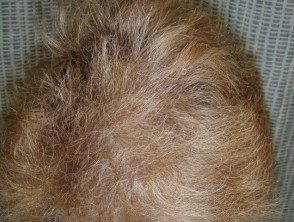
Frizzy hair of unknown cause
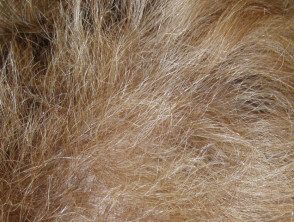
Frizzy hair of unknown cause
What causes hair shaft defects?
Hair shaft defects may be due to external injury or genetic anomaly.
External injury to the hair shaft.
Repeated physical injury is the most common cause of hair growth. fragility. This may be due to:
- excessive grooming
- Traction by braiding or tight ponytail
- The heat of a hair dryer.
A chemical injury can be caused by:
- permanent lotions
- plates
- Dyes
Traction alopecia
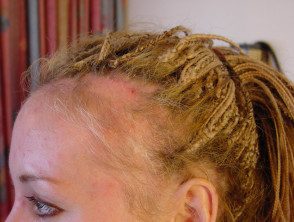
Traction alopecia

Traction alopecia
Genetic abnormalities of the hair shaft
Genetic abnormalities of the hair shaft can be broadly divided into two types: those with increased capillary fragility and those without increased capillary fragility.
| Greater fragility | It does not increase the fragility of the hair. |
|---|---|
|
|
Bubble hair
Bubble hair is characterized by shafts with large "bubbles" inside them. These thin the hair cortex and break the hair shaft.
There may be a genetic predisposition to bubble the hair. However, the presentation is often precipitate by an external injury such as the use of a hair dryer, physical or chemical hair straightening or curling irons.
Beaded hair / monilethrix
The name beaded hair reflects hair shafts with narrow segments between "nodes" of normal thickness. Also called monilethrix. The scalp is most commonly involved.
Affected hair shafts appear beaded a few months after birth. They break off leaving patches of scalp with abnormally short hairs. The scalp can also have a rough appearance due to a buildup of keratin around the hair follicle.
Monilethrix is inherited as a autosomal Dominant feature. This means that an affected individual has a 50% chance of transmitting it to each of their male and female children. It is caused by changes in keratin. gene grouping in chromosome 12 (locus 12q13 genetic map, OMIM ID # 158000).
There is no known treatment.
Beaded hair or monilethrix

Beaded hair or monilethrix

Beaded hair or monilethrix
Pili Torti
Pili torti describes a flattened stem with clusters of narrow twists at irregular intervals. The hairs are abnormally brittle. It can be genetic (inherited) or acquired.
When inherited, pili torti can be present at birth or appear during childhood (OMIM ID% 261900).
Pili torti is associated with various inherited syndromes.
- Other ectodermal abnormalities, including keratosis pilaris, nail disease, and tooth abnormalities.
- Bjornstad syndrome, with sensorineural hearing loss (OMIM ID # 262000).
Bazex syndrome or follicular atrophoderma and basal cell carcinomas (OMIM% ID 301845)
- Menkes disease, an X-linked copper deficiency condition caused by an abnormal copper-transporting ATPase, resulting in mental retardation, motor deficiency, growth failure, and skin hypopigmentation (OMIM ID # 309400). The hair is thin, whitish and resembles "steel wool".
Acquired pili torti can arise in the following circumstances:
- Associated with anorexia nervosa and malnutrition
- following oral retinoid treatment (isotretinoin, acitretin)
- At the edge inflammatory scalp conditions such as cutaneous lupus erythematosus and lichen planopilaris, due to fibrosis (scarring), which distorts the hair follicle.
Bamboo hair / trichorrhexis invaginata
Bamboo hair or trichorrhexis invaginata is due to abnormal keratinization. The hair shaft cortex is structurally weak at specific points along its length. Stronger adjacent segments of the hair shaft impact these softer parts creating a ball and lace look. The hair shaft can be broken with minimal trauma.
The cause is a mutation in the SPINK5 gene (locus 5q32, OMIM ID*605010)
Trichorrhexis invaginata is a classic feature of Netherton syndrome (OMIM ID # 256500).
Trichorhexis nodosa
Trichorrhexis nodosa is the most common abnormality of hair structure. When a weak hair partially fractures and the cortical cells fragment, uneven spurs form at the point of fracture.
Trichorrhexis nodosa can be congenital and occurs in children with mental retardation and argininosuccinic aciduria. (OMIM ID # 207900).
Trichorrhexis nodosa can also be acquired due to hair straightening, overheating with a hair dryer, frequent swimming in chlorinated water, excessive pulling with tight braids, and other forms of hair trauma.
Trichorhexis nodosa
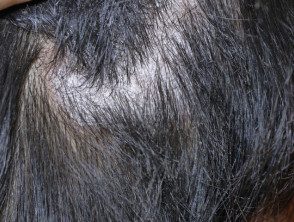
Excessive use of hair dryer.
Trichothiodystrophy
In trichothiodystrophy, the hair shafts are deficient in sulfur, resulting in transverse polarizer fractures microscopy reveals intermittent dark bands.
Trichothiodystrophy may occur as an isolated hair shaft abnormality or may be associated with photosensitivity, ichthyosis, brittle hair, mental retardation, short stature, neurological abnormalities, and nails and teeth dystrophy (Tay syndrome, OMIM ID% 275550).
Acquisition of progressive twisting of hair
Acquired creeping hair is also called pubeshaarnaevus because it resembles pubic hair. In this rare disorder, the hair on the scalp becomes progressively frizzy, frizzy, dry, and difficult to comb.
It usually affects the apex or frontotemporal area of young men and can progress to male pattern baldness (androgenetic alopecia).
Acquired progressive hair waving can also be a side effect of retinoid therapy.
Loose Anagen Hair Syndrome
Loose anagen syndrome is due to defective keratinization of the inner root sheath, rather than the hair shaft. Loose hair can be easily pulled out of the follicle, leaving located or diffuse bald areas of the scalp.
On light microscopy, abnormal hairs are seen to be in the anagen phase and often appear twisted with longitudinal furrows and ruffled cuticles.
Loose (hair) anagen syndrome results in short, brittle hair. Although both sexes can be affected, it most often occurs in girls older than 2 years. They usually have blonde or red hair.
It can be diagnosed by the painless extraction of at least 10 hairs in a hair pull test of which more than 80% of the hairs are in the anagen phase.
It is inherited as a autosomal dominant condition with variable penetrance (OMIM ID 600628). There is no known treatment.
Loose Anagen Hair Syndrome

Loose Anagen Hair Syndrome

Loose Anagen Hair Syndrome

Loose Anagen Hair Syndrome
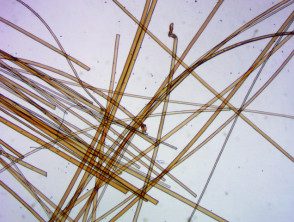
Loose Anagen Hair Syndrome
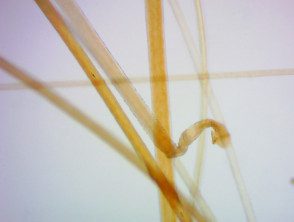
Loose Anagen Hair Syndrome
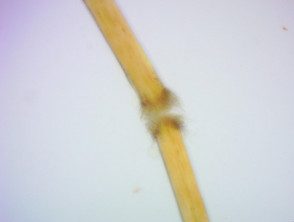
Trichorrhexis in loose hair anagen
Ringed hair / pili annulati
Pili annulati or ringed hair is used to describe hair in which there are scattered clusters of air-filled 'bubbles' along the hair shaft. These appear as bright bands when viewed in reflected light (OMIM ID% 180600).
Pili bifurcati
Pili bifurcati describes abnormal branching of the hair shaft. This can happen at multiple points. The branches often merge again further up the axis. Each branch has its own cuticle.
Spun glass hair / pili trianguli et canaliculi
Spun glass hair is also called pili trianguli et canaliculi, unsupported hair syndrome, and cheveux incoiffables. The hair shafts have an irregular triangular shape in cross section and an abnormal longitudinal groove along the shaft.
Spun glass hair is due to abnormal keratinization of the inner root sheath. This forms an inflexible tube through which the hair shaft must pass, distorting its shape and making it stiff and brittle. The light reflected by the flattened surface gives the hair a “spun glass” appearance.
Spun glass hair is associated with atopy (eczema), alopecia areata and ichthyosis vulgaris. (OMIM ID # 191480).
There is no known treatment for spun glass hair. However, the condition may improve with age.
Peerless Spun Glass Hair
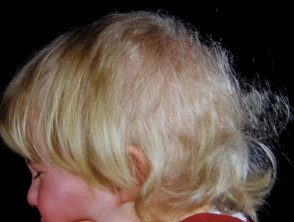
Non-combinable spun glass pile
Woolly hair
Woolly hair describes hair that is unusually frizzy and tightly coiled. Hair shafts have elliptical cross sections, axial twisted and scattered areas of splaying.
It can affect the entire scalp or just a small area when considered a type of birthmark (nevus), woolly hair nevus.
Woolly hair can be inherited as an isolated condition (OMIM ID # 194300) or present as part of a syndrome.
- Enfermedad de Naxos (difusa palmoplantar keratoderma y ventricular derecho cardiomyopathy, OMIM ID # 601214)
Síndrome de Noonan (baja estatura, defecto cardíaco congénito, lentitud mental, hendidura torácica y apariencia facial característica, OMIM ID # 163950).
Otras afecciones que pueden estar asociadas con la presencia de pelo lanoso incluyen queratosis pilaris, ictiosis, dientes anormales y distrofias ungueales.
woolly hair nevus

woolly hair nevus

woolly hair nevus
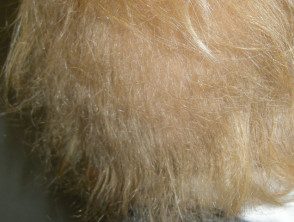
woolly hair nevus
Hair with strands / pili multigemini
El cabello con mechones o pili multigemini describe varios tallos de cabello agrupados y emergiendo de un folículo (como un cepillo de dientes o cabello de muñeca). La microscopía de luz confirma que todos los pelos están rodeados por una sola vaina externa. Los tallos del cabello son normales.
El cabello con mechones es una característica de la cicatrización de las afecciones inflamatorias del cuero cabelludo, particularmente las formas graves de foliculitis del cuero cabelludo conocidas como foliculitis decalvanos y celulitis disecante.
Tufted folliculitis due to folliculitis decalvanus
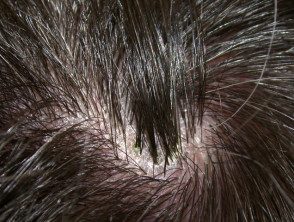
Foliculitis en penacho
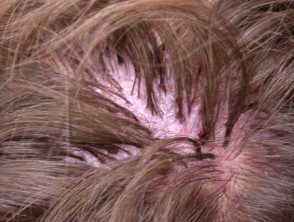
Foliculitis en penacho
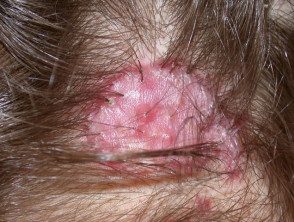
Foliculitis en penacho
Treatment of hair shaft defects
En la actualidad, no existe un tratamiento específico para los trastornos capilares hereditarios estructurales. Ocasionalmente hay una mejora espontánea a medida que el niño envejece.
En los trastornos capilares estructurales adquiridos, detener la exposición al agente causal puede conducir a una mejora.
- Evite la preparación y la tracción excesivas, el trenzado, el tejido del cabello, los tratamientos térmicos, el alisado, la permanente y los tintes.
- Reduzca la exposición a la luz solar: use un sombrero.
- Lave el cabello con un champú suave, diluido en agua tibia.
- Aplica un acondicionador sobre el cabello recién lavado.
- No use un secador de pelo, ni lo use con una configuración fría.
- Suspenda la isotretinoína y la acitretina, a menos que sea esencial.
Se recomienda el cuidado del cabello suave. Los peinados cortos son recomendables. En algunos casos, una peluca o postizo puede ser el enfoque más práctico.

